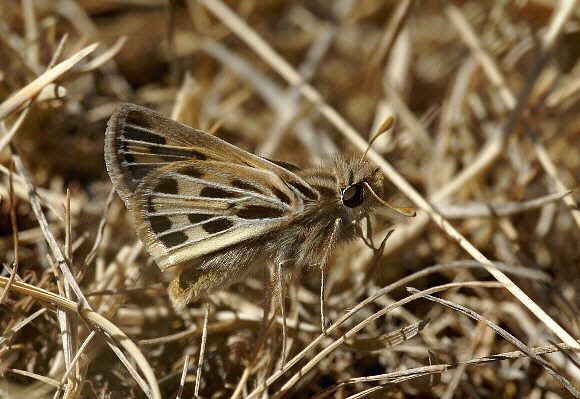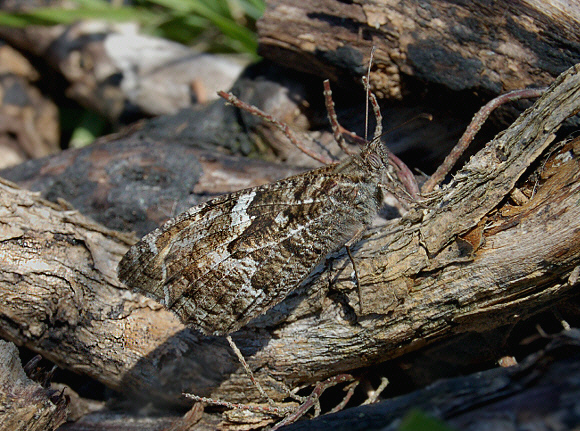 Green Hairstreak Callophrys rubi at rest on green foliage – Adrian Hoskins
Green Hairstreak Callophrys rubi at rest on green foliage – Adrian Hoskins
Butterflies use many means to hide themselves from predators. Sometimes, as with the neotropical metalmarks ( Riodinidae ), they simply hide under leaves, out of sight. Most other species rest in more open situations though, and conceal themselves using techniques such as camouflage, disguise, disruptive coloration or transparency.
The boundary between camouflage and disguise is hard to define, but camouflage is generally considered to describe something with a colour, pattern and texture that enables it to blend well against a natural background or substrate. Butterflies rest on many different substrates including foliage, soil, rocks and tree trunks – and various species possess colours and patterns which match each of these backgrounds.
Disguise on the other hand describes a butterfly or moth that has a similar appearance to another natural object, such as a leaf or flower. Moths often have very effective disguises – some which rest on tree trunks resemble bits of lichen, others resemble bits of broken twig. The caterpillars of many Geometrid moths look exactly like twigs, and even have small projecting false “thorns”.
Camouflage
Amongst British butterflies the Orange tip Anthocharis cardamines is a good example, difficult to spot when at rest on the white flowers of garlic mustard.

Anthocharis cardamines, camouflaged at rest on garlic mustard flowers – Adrian Hoskins
Disguise
The Brimstone Gonepteryx rhamni, is a superb example of disguise, being coloured and shaped like a living leaf, complete with raised “veins”.

Brimstone Gonepteryx rhamni, perfectly disguised as a leaf – Adrian Hoskins
In the tropics there are many species which are disguised as dead brown leaves – examples include the Leaf butterfly Kallima inachus from India, and the Memphis and Marpesia Leafwing butterflies of South America.
 Zaretis itys, a Peruvian species convincingly disguised as a dead leaf – Adrian Hoskins
Zaretis itys, a Peruvian species convincingly disguised as a dead leaf – Adrian Hoskins
Disruptive coloration
This term is used to describe the way in which a butterfly or moth’s appearance is visually broken up, usually by means of mottling and / or prominent lines.
The Angle Shades moth Phlogophora meticulosa is a good example – it is equally well concealed when settled amongst dead vegetation or fallen branches.
Predators – particularly birds, use a “search image” to locate resting moths. They look out for a “moth shaped” object, but the disruptive pattern of the Angle Shades breaks up it’s outline and foils the bird’s search image.

Angle Shades moth Phlogophora meticulosa, Hampshire, England – Adrian Hoskins
 Hylephila peruana, a skipper from Peru. The disruptive patterning makes it very difficult to detect amongst the dry grasslands of it’s habitat in the Andes – Adrian Hoskins
Hylephila peruana, a skipper from Peru. The disruptive patterning makes it very difficult to detect amongst the dry grasslands of it’s habitat in the Andes – Adrian Hoskins
 Grayling Hipparchia semele, perfectly disguised at rest on dead wood – Adrian Hoskins
Grayling Hipparchia semele, perfectly disguised at rest on dead wood – Adrian Hoskins
Transparency
The colours of butterflies are produced either by pigments in the wing-scales, or structurally by light refracting on prism-like ridges on the surface of the scales. Some species however are very thinly scaled or lack wing scales almost entirely, revealing the transparent membrane of the wings.
Butterflies which use transparency to conceal themselves include Ithomiine Glasswings and certain neotropical Satyrines such as Cithaerias pireta and Dulcedo polita. There are also representatives from other families, e.g. Chorinea ( Riodinidae ) and Lamproptera ( Papilionidae ).
 Cithaerias pireta aurora, Cocha Camunga, Rio Madre de Dios, Peru – Adrian Hoskins
Cithaerias pireta aurora, Cocha Camunga, Rio Madre de Dios, Peru – Adrian Hoskins

Vein structure of a transparent Satyrine butterfly Haetera piera – Tony Hoare
